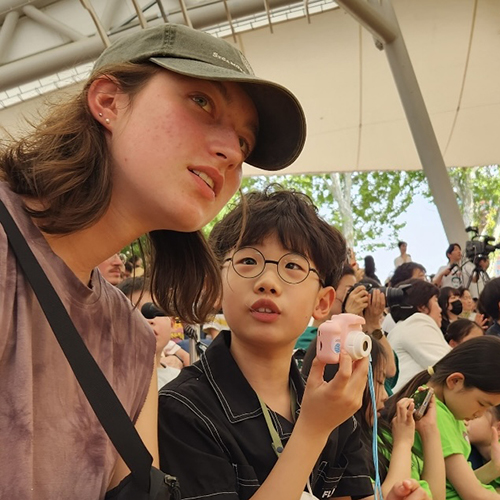UW undergraduate Connie Bobroff has always been fascinated by language. She has been particularly intrigued by Persian. Now she is sharing her fascination through a website she created for advanced students of Persian.
The website, at http://depts. washington.edu/yekruz, analyzes a single story by Persian author Mohammad-Ali Jamalzade. One could spend days—or weeks—exploring the story with Bobroff’s guidance. Each word is translated; each line is annotated with extensive comments and footnotes. A native speaker, UW Professor Ahmad Karimi-Hakkak, provides an audio reading of the text. Every line is shown in handwritten Persian as well as the computerized font. Where an unfamiliar item is mentioned—an uncommon flower, for example—a photograph of the item appears with the click of the mouse.
Bobroff, a Near Eastern languages and civilization major, began working on the website in 2001, after reading Jamalzade’s story during an independent study class with Professor Karimi-Hakkak.
“I remember thinking, ‘This story is too good to lie unopened on library shelves collecting dust,’” recalls Bobroff. “This is a make-you-feel-good story about Iran. It is in the wandering scholar style and is also a mystical journey of self discovery. It’s very Persian, yet very universal. I wanted to share the story with the world.”
But Bobroff did not want to merely translate the story. “Jamalzade was a man with a mission and I wanted to make sure I didn’t lose sight of that,” she says. “His goal was preservation of his language and heritage and you might say this story is a sort of living dictionary or encyclopedia.”
Although Bobroff hoped students would stick to the Persian, she did include a “dull and literal” English translation. Much to her surprise, she says, “people reading the English translation get sucked in, too.”
From the beginning there were challenges in creating the site, from implementing the Persian script to deciding whether to include vowels, which are rarely included in written Persian but are extremely helpful for students. “The minute you put vowels in, you are committing to one or another dialect,” Bobroff explains, “so I put the vowels in the classical style in the Persian text, but put them in the Tehrani dialect in the Latin transliteration. It was a way to present varying ‘Persian’—Iranian, Afghan, and Tajiki.”
Then there was the content. Bobroff spent endless hours consulting reference books in Suzzallo Library, researching the grammar, the culture, and the multiple meanings of words. “Every word pretty much requires a footnote,” she says.
Fortunately, Bobroff had help. Nicholas Heer, retired UW professor of Arabic, was “my secret weapon,” she says. “Besides knowing the ins and outs of Arabic and Persian computing, he answered many of my questions of language and Islam. If he didn’t know the answer himself, he knew someone who did, including contacts in Iran. His readiness to help and enthusiasm were all that kept me going sometimes.”
Bobroff received no UW funding or course credit for her work on the website. It was just something she wanted to do for students like herself, who have studied Persian for several years and want to learn more. She’s been pleased with the response.
“Sometimes I’ll get twenty users a day, sometimes only two,” she says. “I particularly like seeing users in some Godforsaken places coming back day after day, and slowly proceeding through the story line by line. Many email me with heartfelt thanks for putting the story online.”
Professor Karimi-Hakkak, who first introduced Bobroff to Jamalzade’s writing, marvels at what she has accomplished. “This is a unique, state-of-the-art project,” he says, “and it is being discovered day by day for its marvelous potential in advanced language pedagogy, even as a model for learning languages very different from Persian.”
Does Bobroff have any plans to bring another text to the web? Not a chance, she says. “I’m only going to read Persian in the next few years,” she says. “No more web development. I’ve already given it everything I’ve got and I’m exhausted.”
More Stories

A Statistician Weighs in on AI
Statistics professor Zaid Harchaoui, working at the intersection of statistics and computing, explores what AI models do well, where they fall short, and why.

The Mystery of Sugar — in Cellular Processes
Nick Riley's chemistry research aims to understand cellular processes involving sugars, which could one day lead to advances in treating a range of diseases.

Finding Family in Korea Through Language & Plants
Through her love of languages and plants — and some serendipity — UW junior Katie Ruesink connected with a Korean family while studying in Seoul.